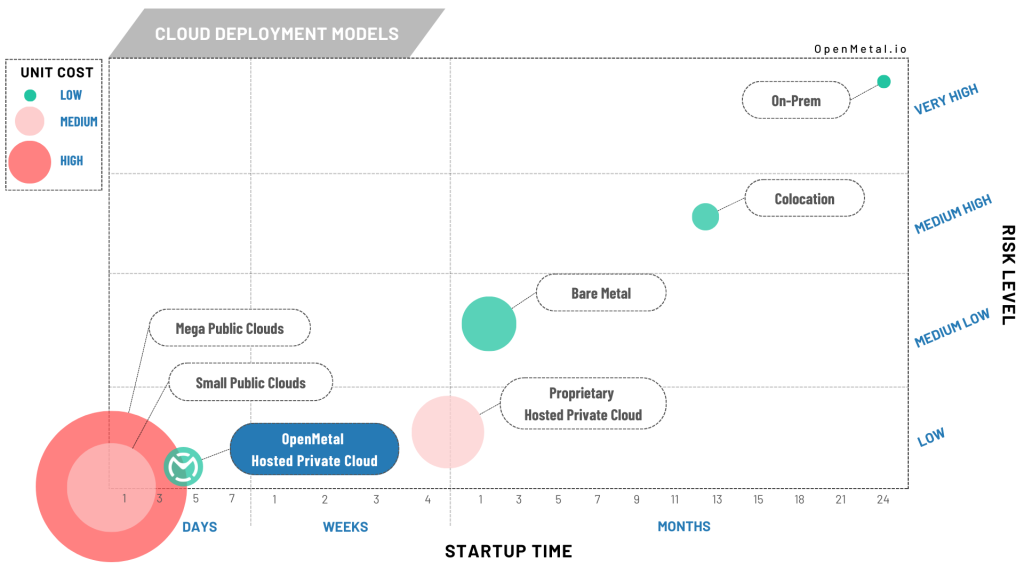What is a Cloud Deployment Model?
A cloud deployment model is the operational approach your company has chosen to follow to provide infrastructure to support a particular computing or storage workload. A company often has multiple cloud deployment models when it has many workloads. This gave rise to the term “multi-cloud” which is not itself a model but a combination of models.
It is key to understand that Cloud has matured dramatically in the last 10 years. In the beginning there were only a few cloud deployment model options. One of these, the public cloud deployment model, was dominant in marketing and in the quality of the cloud experience. Unless you were ok to wait for 1 to 2 years for a quality private cloud your only options was “to move to the cloud” at AWS.
Today, in 2024, there are many easy and fast ways to get Cloud. Below is a list of cloud deployment models that are mature and provide a quality experience when measured against solid cloud native requirements. This is in order of “time to delivery” and I have added a rough cost scale.
For clarity, a repeat: When talking about “cloud” don’t define it as a location. Instead, just think of Cloud as a method of managing workloads. By this I mean don’t thing of it as “moving” but think of it as choosing from a set of cloud deployment models that work for your workload or workloads.
Cloud Deployment Model Options
- Unit Cost = Per Unit Cost of Resource (VMs, Kubernetes Clusters, Block Storage, etc.)
- Startup Time = From decision to when first VM is provisioned for production use.
- Risk = Likelihood of issues that will cause significant delays, missed objectives, or for the project to never complete
- Data Center = Who owns the DC
- Network = Who supplies the switches, routers, dDOS, and internet connectivity
- Servers = Who supplies the physical computers in the DC
- Cloud Install = Who turns the hardware into a cloud native resource pool
The following chart shows a comparison of startup time, risk, and per unit resource cost for these 6 common modern Cloud IaaS deployment models.

On-Premises/Your Data Center Infrastructure (On-Prem) – $
In your data center that you built, with servers you bought. You automated some of your hardware management with things like IPMI, PXE booting, or even using things like standalone OpenStack Ironic. Next you automated access to the hardware with tools like OpenStack, Ceph, Minio, CloudStack, MaaS, VMWare, Nutanix, Proxmox, OpenShift/OKD, Rancher and Longhorn, etc. These systems all generally work the same and will supply a set of APIs or GUIs for self service resource deployment. After you supplied the resulting APIs to your team the VMs, Object Storage, Container Pods, etc can be consumed via automation (or GUI). If you are going down this path we encourage you to still use OpenStack and check out our How to Build a Private Cloud on OpenStack article.
A note on the “Very High” risk for cloud in your data center. Running a cost efficient data center requires so many things to go right – and realistically running a single data center is not at the scale needed to truly be efficient. Add to that you also have to architect an efficient cloud system – it just isn’t realistic for any company below very, very large scale. Colocation is much more common than companies building their own data center for their own use.
See our cost tipping point article for more details, but as you can see, if your company has the time and can navigate the risk, this is the most efficient per unit cost.
Colocation – $$
In a provider’s data center, with servers you bought. Just like On-Prem above, you automated some of your hardware management and you automated your workload deployment. Your end “customer” consumes the VMs, Object Storage, Container infrastructure, etc. just like they do with Public Cloud and what was made above in On-Prem.
If you are looking to move from public cloud to colocation, it would benefit you to explore OpenMetal as a colocation alternative.
Bare Metal/Dedicated Servers – $$
In a provider’s data center, leased hardware was delivered on demand to you, and you loaded on, via IPMI, public cloud alternative software including OpenStack, Ceph, Minio, CloudStack, MaaS, VMWare, Nutanix, OpenShift/OKD, Rancher and Longhorn, Ceph, etc. Then you automated your workload deployment against the APIs or worked in GUIs to deploy.
Many companies, including many startup companies, prefer this and we offer a rich set of bare metal servers specifically for big data, virtualization, and high performance computing.
Hosted Private Cloud – $$
In a provider’s data center, leased hardware was delivered on demand to you as a Cloud, and you automated your workload via APIs against VMs, Object Storage, etc. GUIs are common, but infrastructure as code is more common since users of this technology are both coming from the above cloud deployment models and from the below cloud deployment models.
For System Admins, SREs, Engineers that may have been “born in the cloud”, ie, they have only used the public cloud deployment model, they often do not wish to get back into a GUI approach, manual CLI work, or scripting. Cloud deployment systems like OpenStack, for example, have very robust API first approaches and have consciously deprioritized work on GUIs as that approach has less modern usage.
This is where OpenMetal has innovated and is able to offer private automated cloud native infrastructure. Check out our Hosted Private Cloud or on-demand Private Cloud powered by OpenStack .
Alternative Public Clouds – $$$
Leased from providers like DigitalOcean, Vultr, and Ramnode. You automated your workloads against VMs, Object Storage, etc.
Mega Public Clouds – $$$$$ (5)
The Big 3+, you automate your workloads against both VMs and “time saving” things like serverless. When working in this cloud deployment model a business typically has to introduce some type of “Cloud Financial Operations” or FinOps for short. FinOps is the practice of not letting your cloud provider’s bill run away. Seems simple, but it is anything but and a whole industry and job function has been created over the last few years. In fact, the FinOps Foundation is now formally part of CNCF.
For more cost analysis check out the Public vs Private Cloud Cost Tipping Points to help you understand how the big clouds can get very expensive.
Cloud is not a Destination, it is a Philosophy
This philosophy is worth repeating. Cloud is not a location. When you consider the 6 cloud deployment models available to you, they have different benefits, but all of them end with a high quality cloud native automated set of resources. In the past, it was questionable that there would be a high quality cloud native experience on the other side of an on-premises cloud deployment, for example.
Today though, there are a rich and mature set of software, vendors, and consultants that have changed this landscape. Real things today that are important to point out:
- Rich, high quality “on-demand private cloud as a service” is a real thing – OpenMetal is the market leader in this, but others exist
- Rich, high quality “bare metal as a service” is a real thing – OpenMetal is one of the leaders, but many others exist as well
A few cloud deployment model final thoughts
A few final thoughts.
- Moving your workloads off the mega clouds does not mean you are “leaving the cloud”. You are leaving the mega clouds.
- When talking about “cloud” I don’t define it as a location. Instead, just think of Cloud as a method of managing workloads. By this I mean you don’t have to “move”!
- Private Cloud does not mean “on-prem” as “on-prem” doesn’t even mean in your own data center anymore.
- Private cloud in a colocation facility is very common
- Hosted Private Cloud, on-demand private cloud, or private cloud as-a-service is relatively new, but growing quickly, it is a great way to be both flexible like a traditional public cloud and cost effective like a private cloud. Learn more on our homepage.
Interested in OpenMetal Cloud?
Schedule a Consultation
Get a deeper assessment and discuss your unique requirements.



































